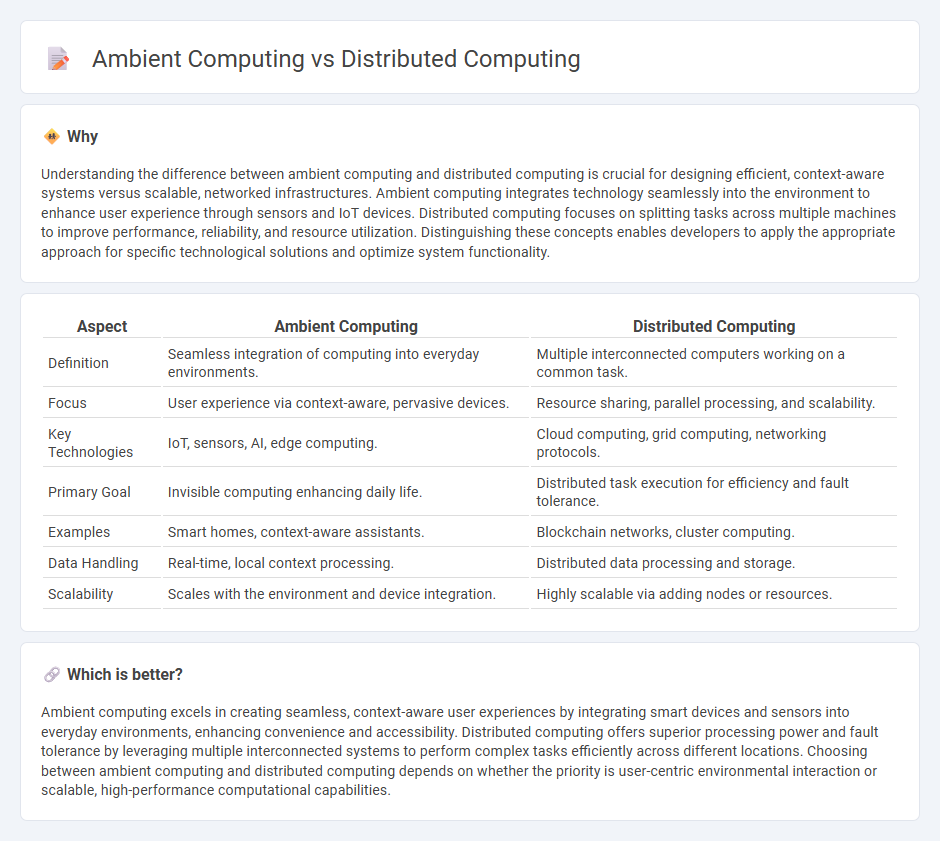
Ambient computing integrates smart devices seamlessly into everyday environments to provide context-aware and intuitive user experiences. Distributed computing involves multiple interconnected systems working collaboratively to process data, enhance scalability, and improve fault tolerance. Discover more about how these technologies transform digital interactions and enterprise solutions.
Why it is important
Understanding the difference between ambient computing and distributed computing is crucial for designing efficient, context-aware systems versus scalable, networked infrastructures. Ambient computing integrates technology seamlessly into the environment to enhance user experience through sensors and IoT devices. Distributed computing focuses on splitting tasks across multiple machines to improve performance, reliability, and resource utilization. Distinguishing these concepts enables developers to apply the appropriate approach for specific technological solutions and optimize system functionality.
Comparison Table
| Aspect | Ambient Computing | Distributed Computing |
|---|---|---|
| Definition | Seamless integration of computing into everyday environments. | Multiple interconnected computers working on a common task. |
| Focus | User experience via context-aware, pervasive devices. | Resource sharing, parallel processing, and scalability. |
| Key Technologies | IoT, sensors, AI, edge computing. | Cloud computing, grid computing, networking protocols. |
| Primary Goal | Invisible computing enhancing daily life. | Distributed task execution for efficiency and fault tolerance. |
| Examples | Smart homes, context-aware assistants. | Blockchain networks, cluster computing. |
| Data Handling | Real-time, local context processing. | Distributed data processing and storage. |
| Scalability | Scales with the environment and device integration. | Highly scalable via adding nodes or resources. |
Which is better?
Ambient computing excels in creating seamless, context-aware user experiences by integrating smart devices and sensors into everyday environments, enhancing convenience and accessibility. Distributed computing offers superior processing power and fault tolerance by leveraging multiple interconnected systems to perform complex tasks efficiently across different locations. Choosing between ambient computing and distributed computing depends on whether the priority is user-centric environmental interaction or scalable, high-performance computational capabilities.
Connection
Ambient computing relies on distributed computing frameworks to enable seamless interaction between interconnected devices and systems in a smart environment. Distributed computing provides the necessary infrastructure for processing data across multiple nodes, ensuring low latency and real-time responsiveness crucial for ambient intelligence applications. This synergy enhances context-awareness and scalability in technologies like IoT, smart homes, and wearable devices.
Key Terms
Node
Node excels in distributed computing by enabling scalable, event-driven applications across multiple devices or servers, providing efficient resource sharing and parallel processing. Given its lightweight runtime and asynchronous I/O model, Node.js supports seamless communication and coordination in ambient computing environments where context-aware, sensor-driven interactions occur. Discover how Node's architecture bridges distributed and ambient computing paradigms for cutting-edge, interconnected solutions.
Context-awareness
Distributed computing leverages multiple interconnected devices to perform complex tasks collaboratively, often emphasizing scalability and resource sharing. Ambient computing prioritizes seamless context-awareness, enabling systems to adapt dynamically to users' environments and behaviors for intuitive interaction. Explore further to understand how context-aware technologies redefine user experiences in both paradigms.
Middleware
Middleware in distributed computing acts as an intermediary layer that enables seamless communication, resource sharing, and data management across heterogeneous networked systems, supporting scalability and fault tolerance. In ambient computing, middleware integrates context-aware services and device interoperability within smart environments, ensuring real-time responsiveness and adaptive user experiences through sensor data processing. Explore further to understand how middleware technologies evolve to bridge the gap between distributed systems and ambient intelligence.
Source and External Links
What is Distributed Computing? | Definition from TechTarget - Distributed computing is a model where software components are spread across multiple computers or nodes that communicate and coordinate via messages to perform tasks in parallel, enhancing performance, resilience, and scalability through task distribution, parallel execution, communication, result aggregation, and fault tolerance.
What is Distributed Computing? - Distributed computing makes multiple computers work together as a single powerful system to solve complex problems, offering advantages like scalability, fault tolerance, consistency, transparency, and efficiency.
What is Distributed Computing? - Distributed computing systems distribute processing and data storage across multiple devices that communicate over a network, often using peer-to-peer architecture to share resources and scale horizontally by adding more devices.
 dowidth.com
dowidth.com